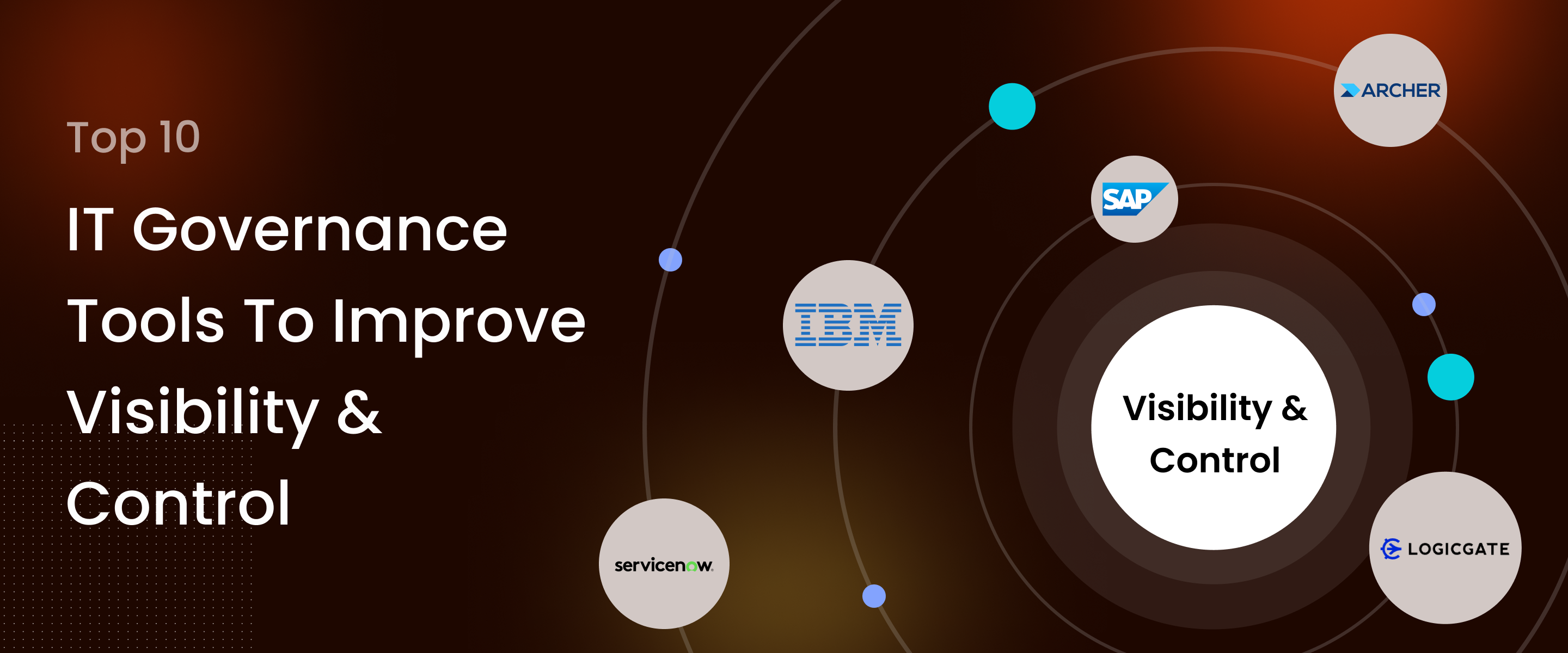

Sign Up
What is best time for the call?
Oops! Something went wrong while submitting the form.

In 2025, IT governance is more critical than ever. With increasing regulatory demands, security threats, and the complexity of multi-cloud environments, CIOs must ensure real-time visibility, enforce policies, and align IT with business objectives. IT governance tools help enterprises maintain compliance, mitigate risks, and improve IT operations through automation, monitoring, and policy enforcement.
IT governance establishes frameworks to ensure IT aligns with business goals while maintaining security, compliance, and efficiency.
IT governance frameworks help organizations:
The ITIL framework is a cornerstone of effective IT Service Management (ITSM) and addresses several critical areas:
The comprehensive coverage offered by ITIL equips organizations to implement a structured approach to ITSM, promoting efficiency and customer satisfaction across technology services.
In today’s fast-paced digital landscape, CIOs need to leverage a variety of frameworks to stay ahead. Here are some pivotal ones that can shape IT strategies and boost business performance:
These frameworks serve as indispensable tools for CIOs aiming to enhance performance, streamline processes, and achieve superior business outcomes. By integrating them into their organizational strategies, CIOs can unlock new opportunities for growth and innovation.
.png)
CIOs face the daunting task of ensuring smooth and efficient IT operations. To accomplish this, they utilize several key ITIL (Information Technology Infrastructure Library) tools, each designed to tackle specific challenges:
These diverse ITIL tools are fundamental for CIOs, aiding them in steering their organizations toward sustained success by maintaining high standards of service and operational excellence.
Overview: ServiceNow GRC provides AI-driven governance, risk, and compliance automation to help enterprises streamline IT governance.
Pros:
Cons:
User Ratings:
Screenshot:

Overview: IBM OpenPages offers enterprise-grade IT governance, integrating AI-driven risk and compliance management.
Pros:
Cons:
User Ratings:
Screenshot:

Overview: RSA Archer enables organizations to automate risk management, policy enforcement, and regulatory compliance.
Pros:
Cons:
User Ratings:
Screenshot:

.png)
Overview: LogicGate Risk Cloud provides cloud-native IT governance, featuring risk analytics and workflow automation.
Pros:
Cons:
User Ratings:
Screenshot:

Overview: OneTrust offers a comprehensive IT governance suite with data privacy, policy enforcement, and compliance automation.
Pros:
Cons:
User Ratings:
Screenshot:

Overview: SAP GRC provides enterprise IT governance and regulatory compliance solutions with deep integration into SAP systems.
Pros:
Cons:
User Ratings:
Screenshot:

.png)
Overview: Qualys PC continuously monitors IT governance policies and enforces compliance requirements in real-time.
Pros:
Cons:
User Ratings:
Screenshot:

Overview: ZenGRC is a scalable IT governance framework that automates compliance tracking and risk assessments.
Pros:
Cons:
User Ratings:
Screenshot:

Overview: Hyperproof provides AI-powered IT risk management and compliance automation for governance teams.
Pros:
Cons:
User Ratings:
Screenshot:

Overview: MetricStream provides end-to-end IT governance lifecycle management and risk analytics.
Pros:
Cons:
User Ratings:
Screenshot:

What are the best IT governance tools for enterprises in 2025?
The best IT governance tools include ServiceNow GRC, IBM OpenPages, RSA Archer, LogicGate Risk Cloud, and OneTrust IT Governance Suite, among others.
How do IT governance solutions improve visibility and risk management?
They provide real-time insights into IT assets, automate compliance reporting, and enforce policies to mitigate risks.
Can AI-driven IT governance tools automate policy enforcement?
Yes, many IT governance tools leverage AI to detect policy violations, enforce governance, and automate compliance tracking.
What’s the difference between IT governance and IT compliance management?
IT governance focuses on aligning IT with business goals, while IT compliance ensures adherence to regulations and policies.
IT governance tools are essential for enterprises looking to enhance visibility, enforce policies, and meet regulatory requirements. With automation, AI-driven insights, and real-time compliance tracking, CIOs can proactively manage IT risks and governance challenges.
📌 Book a Free Demo to see CloudNuro in action!
.png)
Request a no cost, no obligation free assessment —just 15 minutes to savings!
Get StartedIn 2025, IT governance is more critical than ever. With increasing regulatory demands, security threats, and the complexity of multi-cloud environments, CIOs must ensure real-time visibility, enforce policies, and align IT with business objectives. IT governance tools help enterprises maintain compliance, mitigate risks, and improve IT operations through automation, monitoring, and policy enforcement.
IT governance establishes frameworks to ensure IT aligns with business goals while maintaining security, compliance, and efficiency.
IT governance frameworks help organizations:
The ITIL framework is a cornerstone of effective IT Service Management (ITSM) and addresses several critical areas:
The comprehensive coverage offered by ITIL equips organizations to implement a structured approach to ITSM, promoting efficiency and customer satisfaction across technology services.
In today’s fast-paced digital landscape, CIOs need to leverage a variety of frameworks to stay ahead. Here are some pivotal ones that can shape IT strategies and boost business performance:
These frameworks serve as indispensable tools for CIOs aiming to enhance performance, streamline processes, and achieve superior business outcomes. By integrating them into their organizational strategies, CIOs can unlock new opportunities for growth and innovation.
.png)
CIOs face the daunting task of ensuring smooth and efficient IT operations. To accomplish this, they utilize several key ITIL (Information Technology Infrastructure Library) tools, each designed to tackle specific challenges:
These diverse ITIL tools are fundamental for CIOs, aiding them in steering their organizations toward sustained success by maintaining high standards of service and operational excellence.
Overview: ServiceNow GRC provides AI-driven governance, risk, and compliance automation to help enterprises streamline IT governance.
Pros:
Cons:
User Ratings:
Screenshot:

Overview: IBM OpenPages offers enterprise-grade IT governance, integrating AI-driven risk and compliance management.
Pros:
Cons:
User Ratings:
Screenshot:

Overview: RSA Archer enables organizations to automate risk management, policy enforcement, and regulatory compliance.
Pros:
Cons:
User Ratings:
Screenshot:

.png)
Overview: LogicGate Risk Cloud provides cloud-native IT governance, featuring risk analytics and workflow automation.
Pros:
Cons:
User Ratings:
Screenshot:

Overview: OneTrust offers a comprehensive IT governance suite with data privacy, policy enforcement, and compliance automation.
Pros:
Cons:
User Ratings:
Screenshot:

Overview: SAP GRC provides enterprise IT governance and regulatory compliance solutions with deep integration into SAP systems.
Pros:
Cons:
User Ratings:
Screenshot:

.png)
Overview: Qualys PC continuously monitors IT governance policies and enforces compliance requirements in real-time.
Pros:
Cons:
User Ratings:
Screenshot:

Overview: ZenGRC is a scalable IT governance framework that automates compliance tracking and risk assessments.
Pros:
Cons:
User Ratings:
Screenshot:

Overview: Hyperproof provides AI-powered IT risk management and compliance automation for governance teams.
Pros:
Cons:
User Ratings:
Screenshot:

Overview: MetricStream provides end-to-end IT governance lifecycle management and risk analytics.
Pros:
Cons:
User Ratings:
Screenshot:

What are the best IT governance tools for enterprises in 2025?
The best IT governance tools include ServiceNow GRC, IBM OpenPages, RSA Archer, LogicGate Risk Cloud, and OneTrust IT Governance Suite, among others.
How do IT governance solutions improve visibility and risk management?
They provide real-time insights into IT assets, automate compliance reporting, and enforce policies to mitigate risks.
Can AI-driven IT governance tools automate policy enforcement?
Yes, many IT governance tools leverage AI to detect policy violations, enforce governance, and automate compliance tracking.
What’s the difference between IT governance and IT compliance management?
IT governance focuses on aligning IT with business goals, while IT compliance ensures adherence to regulations and policies.
IT governance tools are essential for enterprises looking to enhance visibility, enforce policies, and meet regulatory requirements. With automation, AI-driven insights, and real-time compliance tracking, CIOs can proactively manage IT risks and governance challenges.
📌 Book a Free Demo to see CloudNuro in action!
.png)
Request a no cost, no obligation free assessment - just 15 minutes to savings!
Get StartedWe're offering complimentary ServiceNow license assessments to only 25 enterprises this quarter who want to unlock immediate savings without disrupting operations.
Get Free AssessmentGet Started

Recognized Leader in SaaS Management Platforms by Info-Tech SoftwareReviews
